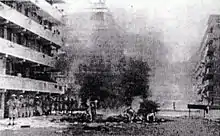| 1956 Hong Kong riots | ||||
|---|---|---|---|---|
 Members of the Royal Hong Kong Police Force dispatched to quell the riots | ||||
| Date | 10–12 October 1956 | |||
| Location | ||||
| Caused by | Several provocations, particularly the removal of the Republic of China flag and the large "Double Ten" emblem hanging from Lei Cheng Uk Estate. | |||
| Goals |
| |||
| Methods | Demonstrations, strikes, arsons, occupations of buildings, attacks against police | |||
| Resulted in | Protests quelled
| |||
| Parties | ||||
| ||||
| Lead figures | ||||
Alexander Grantham | ||||
| Units involved | ||||
| Casualties | ||||
| Death(s) | 59 | |||
| Injuries | 500 | |||
| Arrested | 6,000[1] | |||
| Charged | 2,195[1] | |||
| 1956 Hong Kong riots | |||||||||||||
|---|---|---|---|---|---|---|---|---|---|---|---|---|---|
 Protest photos | |||||||||||||
| Traditional Chinese | 雙十暴動 | ||||||||||||
| Simplified Chinese | 双十暴动 | ||||||||||||
| Literal meaning | Double Ten riots | ||||||||||||
| |||||||||||||
The 1956 Hong Kong riots, also known as the Double Ten riots (Chinese: 雙十暴動), were the result of escalating provocations between the pro-Kuomintang and pro-CCP camps on Double Ten Day, 10 October 1956.[2]
Most violence took place in the town of Tsuen Wan, five miles from central Kowloon. A mob stormed and ransacked a clinic and welfare centre, killing four civilians.[3]
The protests spread to other parts of Kowloon including along Nathan Road. By 11 October, some of the mob began targeting foreigners. Protesters in Kowloon turned over a taxi carrying the Swiss Vice Consul Fritz Ernst and his wife on Nathan Road. The rioters doused the cab in gasoline and lit it on fire resulting in the death of the driver and Mrs. Ernst who succumbed to her injuries two days later.[4]
To quell the riots, Colonial Secretary Edgeworth B. David ordered extra manpower from the British Forces Hong Kong, including armoured troops of 7th Hussars, to reinforce the Hong Kong Police Force in protecting civilians and dispersing the rioters.[3] In total, there were 59 deaths and approximately 500 injuries. Property damage was estimated at US$1,000,000.[2][5]
See also
References
- 1 2 "Two riots and one unrest during 50s and 60s of Hong Kong, killing 111 in total. Curfew and martial law once implemented". Ming Pao (in Chinese (Hong Kong)). 15 February 2016. Retrieved 1 March 2020.
- 1 2 HKheadline.com. "HKheadline.com." 雙十暴動:香港最血腥的一天. Retrieved on 7 July 2010.
- 1 2 "Hong Kong: Trouble on the Double Ten", Time Monday, 22 Oct. 1956
- ↑ "Trouble on the Double Tenth: Riots, Fear And Sudden Death In Hong Kong" (PDF). The Pagoda Magazine. Vol. 17, no. 22. Jamaica BWI: Pagoda Ltd. 3 November 1956. pp. 3, 15. Retrieved 26 August 2019.
- ↑ Chu, Yingchi. [2003] (2003). Hong Kong Cinema: Coloniser, Motherland and Self. Routledge publishing. ISBN 0-7007-1746-3